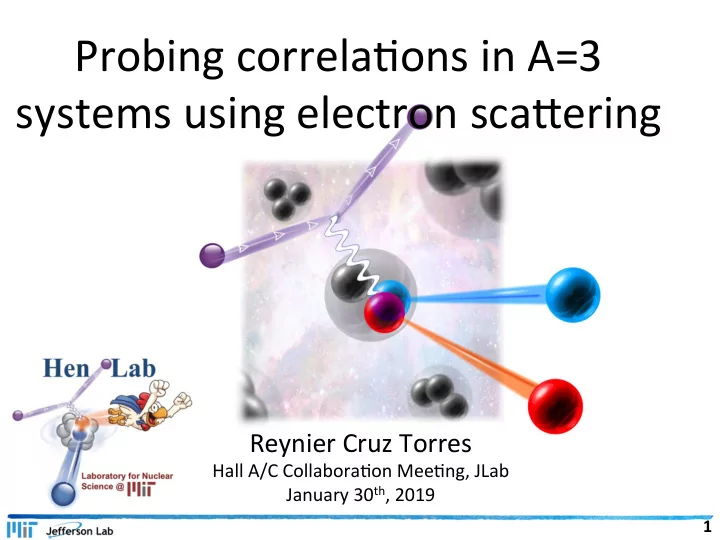

Probing correla4ons in A=3 systems using electron scaEering Reynier Cruz Torres Hall A/C Collabora4on Mee4ng, JLab January 30 th , 2019 1
Nucleon-nucleon interac4on Crucial star4ng point for modern calcula4ons of nuclear structure and reac4ons, and the proper4es of dense astrophysical objects such as neutron stars. Strong nuclear force, Coulomb force, spins, magne4c moments … 2
Nucleon-nucleon interac4on Crucial star4ng point for modern calcula4ons of nuclear structure and reac4ons, and the proper4es of dense astrophysical objects such as neutron stars. Strong nuclear force, Coulomb force, spins, magne4c moments … Residual interac4on from interac4on between nucleon cons4tuents 3
Take your pick! Hamada-Johnston Poten4al Extended SoY-Core • • Yale-Group Poten4al Nijmegen Op4cal Poten4als • • Reid68 Poten4al Hamburg-Group Poten4als • • Reid-Day Poten4al Moscow-Group Poten4als • • Partovi-Lomon Poten4al Budapest(IS)-Group Poten4al • • Paris-Group Poten4als MIK-Group Poten4al • • Stony-Brook Poten4al Imaginary Poten4als • • dTRS Super-SoY-Core Poten4als QCD-Inspired Poten4als • • Funabashi Poten4als The Oxford Poten4al • • Urbana-Group Poten4als The First CHPT NN Poten4als • • Argonne-Group Poten4als Sao Paulo-Group CHPT Poten4als • • ArgonneV14 Munich-Group CHPT Poten4als • • Argonne V28 Idaho-Group CHPT Poten4als • • ArgonneV18 Bochum-Julich-Group CHPT • • Bonn-Group Poten4als Poten4als • Full-Bonn Poten4al LO Poten4als • • CD-Bonn Poten4al NLO Poten4als • • Padua-Group Poten4al NNLO Poten4als • • Nijmegen-Group Poten4als NNNLO Poten4als • • Nijm78 Poten4al and more! • • Par4al-Wave-Analysis • Nijm93 • NijmI • NijmII • Reid93 Poten4al • arXiv:nucl-th/0702078 4
Short-range behavior in unconstrained 5
Why light nuclei? Many of their proper4es can be: - precisely measured. - exactly calculated for a given two- and three-nucleon interac4on model. Why Tri4um? - Isospin doublet: - 3 He is stable mirror nucleus 6
Previous studies and non-QE mechanisms 3 He F. Benmokhtar et al., PRL 94, 082305 (2005) 7
Minimizing non-QE mechanisms Q 2 > 2 GeV 2 x B > 1 8
Minimizing non-QE mechanisms σ Full /σ PWIA Deuteron Boeglin et al., PRL 107 (2011) 262501 9
Further minimizing FSI: 3 He/ 3 H ra4o In PWIA: thus: σ 3He(e,e’p) S 3He (| p i |,E i ) ≅ σ 3H(e,e’p) S 3H (| p i |,E i ) 10
Further minimizing FSI: 3 He/ 3 H ra4o R =2 k 11
SRC and np-dominance Single Nucleon Behavior np-SRC pairs 12
3 He/ 3 H ra4o theory predic4ons 3 He ( p ) 3 He ( p ) 3 H ( p ) ≅ 3 He ( n ) R =2 k 13
3 He/ 3 H ra4o theory predic4ons A - 1 (single-nucleon A - 2 Transi4on behavior) Region (2N-SRC behavior) k 14
3 He/ 3 H ra4o theory predic4ons k 15
Missing momentum p miss = p p - q q a proxi for the nucleon momentum before the interac4on took place 16
Kinema4cal seongs 3.5 GeV/c 20.9 o E beam = 4.3 GeV 58.5 o low-P miss 48.8 o 1.2 kinema4cs GeV/c Counts 1.5 GeV/c high-P miss kinema4cs 17
Measured 3 He/ 3 H ra4o Measurement Simula4on 18
Correc4ons 19
Final results 20
Final results 21
BeEer agreement with PWIA calcula4ons 3 He 22
Effect of Final-State Interac4ons PWIA FSI-f1 FSI-f2 10% [PRELIMINARY] 5% ( 3 He/ 3 H) FSI 1 ( 3 He/ 3 H) PWIA 5% calcula4on by 10% M. Sargsian 23
what causes high-p miss ~30% discrepancy NN models? FSI? 24
Thank you! “…Physicists have devoted […] probably more man-hours [to this ques4on] than have been given to any other scien4fic ques4on in the history of mankind.” Hans A. Bethe “What holds the nucleus together”, Scien4fic American 189, 58 (1953). 25
Recommend
More recommend